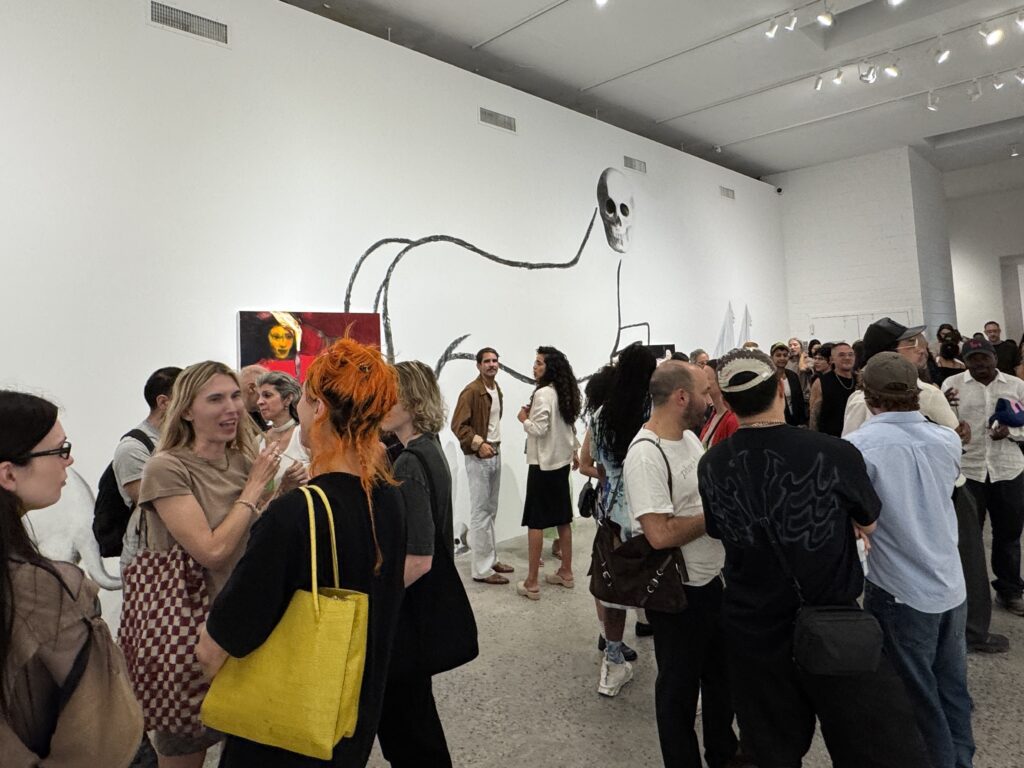
Light bites instead of a seated dinner? Terrible wine? We don’t mind! Spirits were high in the New York art world last week, it seemed. Fascism’s pall could be collectively willed away for several consecutive minutes at a time; conversation, when it did turn serious, often referred abstractly to the window of opportunity we might find in the collapse of institutions, to the silver lining of a market in decline, and so on. A spate of articles on the end of cultural criticism and the total lunar eclipse in Pisces drew me intermittently into a state of self-reflection, but even that wasn’t all bad.
Last September, as I wrote in my Big Picture column—my first piece for the then brand new Critics’ Table (!)—I started the season outside the Times Square Olive Garden. Last Wednesday, I began it at the perhaps equally unlikely Fulton Transit Center in Lower Manhattan—that sleek, sunlit commuter hub like almost nothing else in the subway system’s decrepit warren of tunnels. (I guess there’s something appealing to me about starting “Armory Art Week” at the outer limit of its social-spatial bubble.) I was there for the launch of artist Chloë Bass’s If you hear something, free something, a public sound work presented by Creative Time in partnership with MTA Arts & Design. A small crowd gathered on the building’s below-ground main level to watch performers, positioned in various places around the atrium, read a series of “announcements” that, recorded in five languages, will play in 14 stations through Oct. 5.
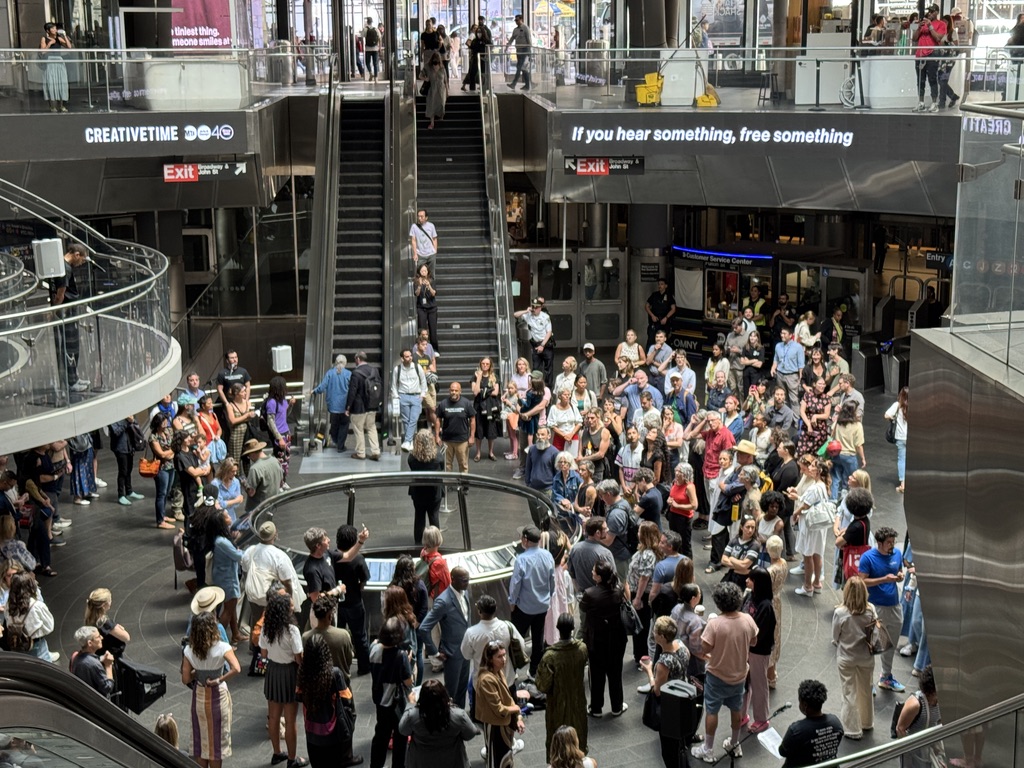
As the work’s title suggests, the audio snippets encourage contemplation and connection—the celebration of “all these little private worlds coinciding out in public,” one voice muses—instead of, say, racist paranoia. The audience was delighted. So was I, though the somber associations of the warm, early-September weather and financial-district site weren’t lost on me—especially in light of Bass’s deep riff on the Department of Homeland Security’s indelible post-9/11 “If You See Something” tagline. The artist’s approach may seem subtle given the stakes of our moment, but I did think, as I boarded my train, heading uptown, that she might have the right idea, that her quixotic intervention in straphanger psychogeography might at least help spread the radical communist DEI value of being neighborly.
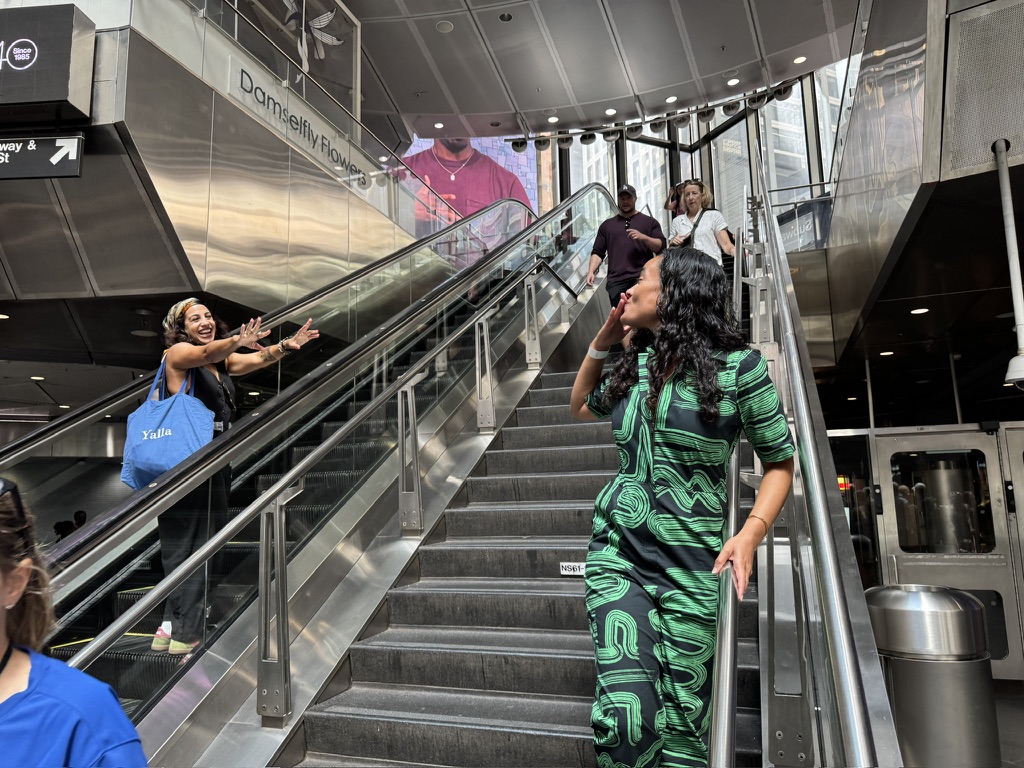
By early evening, I’m in Chinatown, making my way through the crowd of gallery-goers on the sidewalk at Pike Street and Henry. I squeeze by Jerry Saltz to see Matthew Kirk’s show of patchworked assemblage-paintings at Fierman. (David Fierman reminds me to go to the new fair he’s organized—Open Invitational in Tribeca–and I assure him it’s on my list.) I bump into artist Alina Bliumis as I leave, who tells me about her summer in Japan. Then, to my surprise, I find myself being embraced by painter Issy Wood—a major figure in my last diary: She’s in town from London briefly, before flying to Berlin to open her show at Schinkel Pavillon. Issy points me toward writer Naomi Fry who gamely poses with artist Ohad Meromi (her husband) when I tell her I need pictures for my diary. Ohad, who is a non-smoker, he insists, first has to grab a cigarette for the shot: “It looks better with the work.”
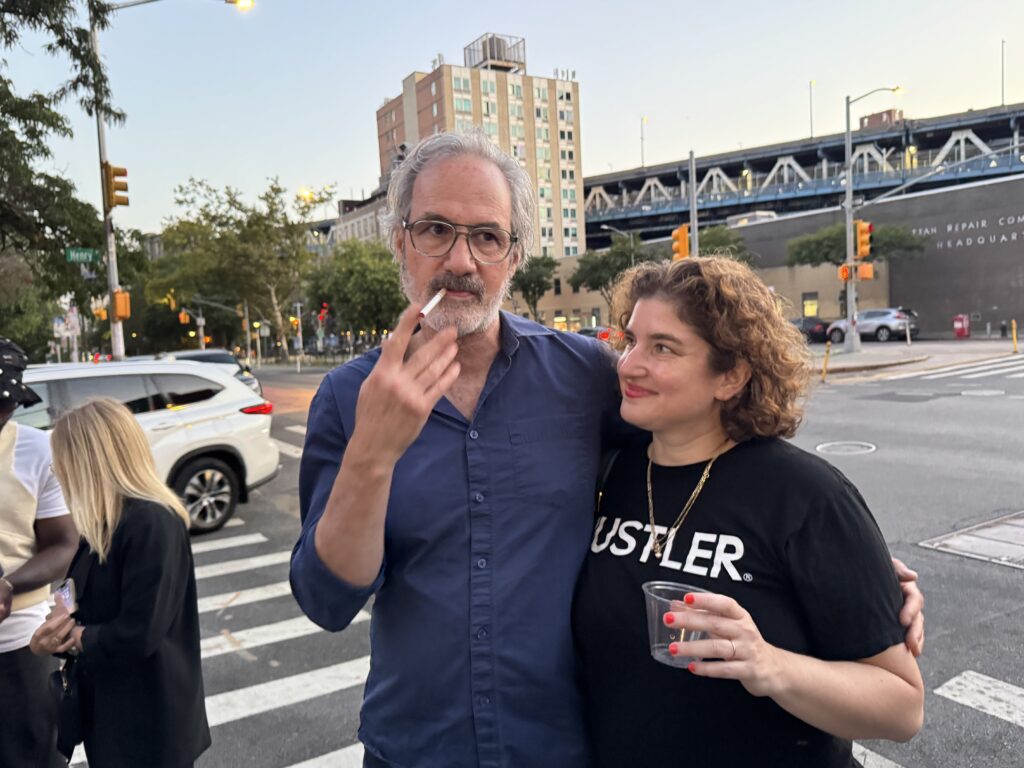
The work, which fills both of 56 Henry’s locations, uses smoking—or not smoking—as a kind of narrative conceit; the assorted sculptures and paintings were produced in the aftermath of his quitting. And so, cigarettes, as geometric forms or apparitions, realistically rendered or abstract, sneak into wall-based compositions and maybe echo in the attenuated limbs of his large-scale, somewhat comic, reclining figures—languidly pensive, a little checked-out. Some works channel Archipenko, which I love. But, I don’t look as closely as I’d like; my vantages are partially blocked by people chatting, and time is running out for me to get to Zoe Leonard’s opening. I want to see the show before everyone decamps to Parcelle.
Maxwell Graham Gallery on Hester Street is busy, but not so full that I can’t absorb the spare installation of black-and-white photos. It’s stunning even in the hubbub. Made from negatives shot in the ’90s, of armor on display—full suits, standing upright in cases, dating from antiquity through the Middle Ages—the chilling images are mournful witnesses to (or emissaries of) necro-patriarchies past. And where the photographer herself is reflected in the museum’s protective glass, she seems to become a time traveler too.
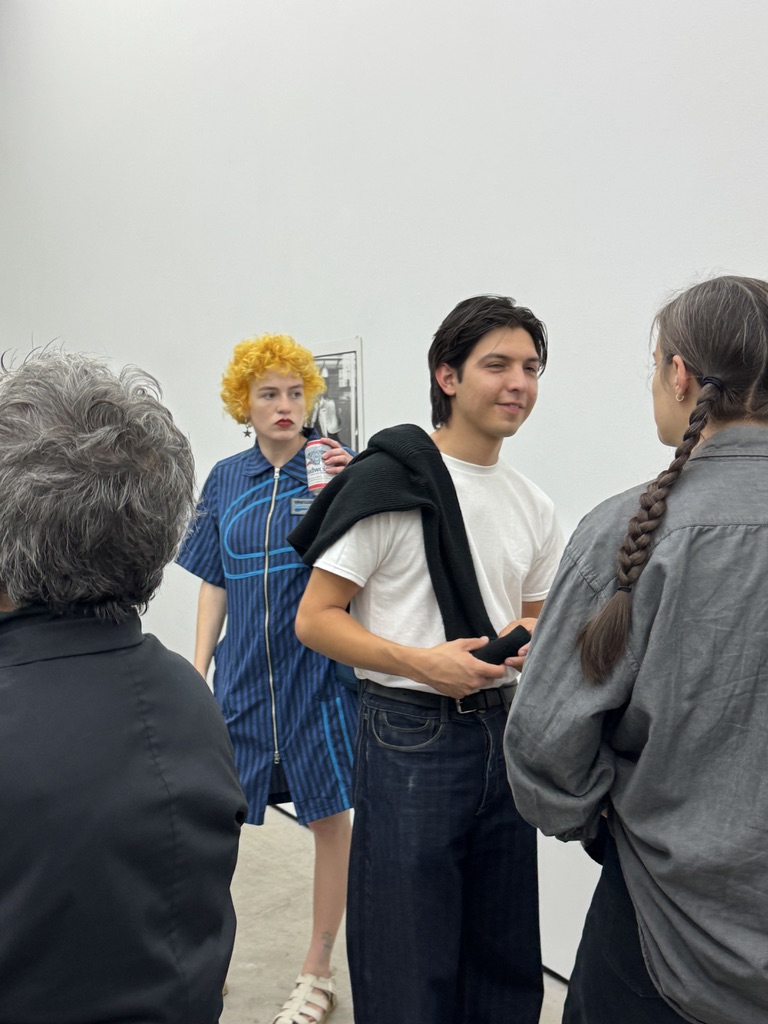
I try to capture the ad hoc convening of Critics’ Table writers in the gallery—Ajay Kurian, Paige K. Bradley, and Domenick Ammirati are all there (my attempt at a group portrait did none of them justice). While talking with Participant Inc director Lia Gangitano, I sense artist K8 Hardy’s presence to my left: a tall figure with wiglike orange hair wearing the artist’s hallmark multiple, her Studio Dress. But I realize, when the figure moves away, that we are, in fact, in the presence of a young doppelganger, who is somehow able—as K8 would be—to make the gallery’s harsh lighting part of her total look. (While K8 doesn’t have orange hair at the moment, I’m pretty sure she did at one time.) I text her a clandestine photo of the intriguing character, and she replies that mine isn’t the first such alert she’s received. I hope to draw this mystery out, to make it a thing, but this isn’t the ’90s. (Everyone’s on Instagram.) On my way out, I congratulate a radiant Zoe. I’m tempted now to list the opening’s attendees, clustered near the reception desk and on the street, as celebrity sightings—to compile a who’s who of a certain generation and milieu of New York artists—and that might be taking this diary thing too far.
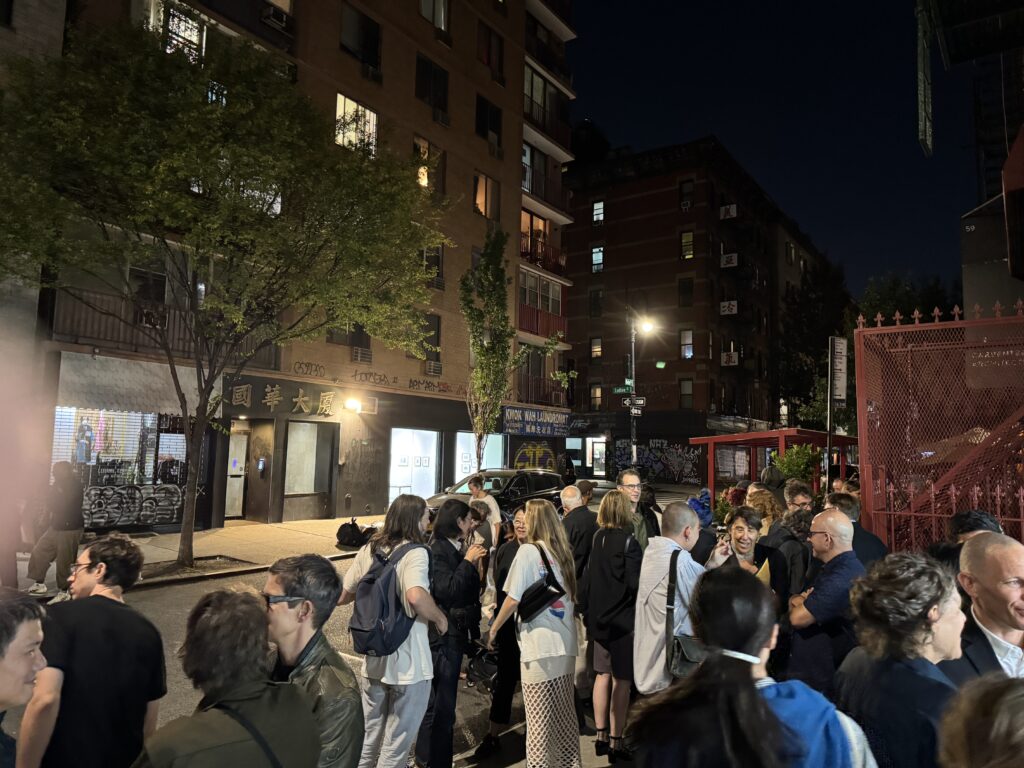
Thursday, I’d planned to meet the artist Alex Jovanovich in Chelsea for a morning walkthrough of the superb Paul Feeley show at Garth Greenan Gallery before the fairs, but I miraculously run into him on the train on my way there. Lloyd Wise (who is, like Issy, also featured in my August diary) shows us around Feeley’s late works. The color field painter, Helen Frankenthaler’s teacher at Bennington in the late ’40s, turned to sculpture in the last years of his short life, in the ’60s. Intersecting pairs of colorful quatrefoil forms, free-standing butterfly-like X’s, anchor and organize the space. There are paintings, drawings, and preparatory works on view, too. Alex and I, both very into miniatures, mime breaking a vitrine to steal the artist’s simple but exquisite maquettes. Instead, from the beautiful breakfast spread by the door, I grab a miniature scone for the road.
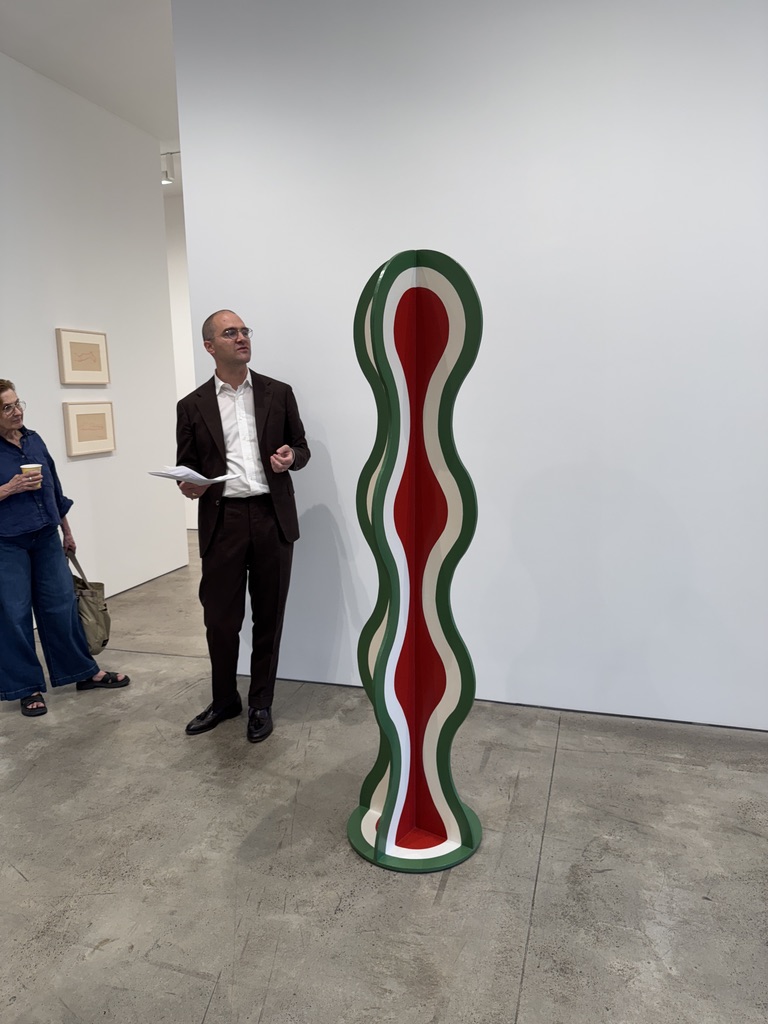
I do at this point get in a cab to the Armory, but the only things I remember from it are a painting of strawberries (Adrianne Rubenstein at the ILY2 booth) and a tabletop Calder (in Berggruen Gallery’s impulse-buy selection by the exit); I must have blacked out. I’m kidding, of course. Or am I? By 6, I’m at a sports bar on 8th Avenue—I didn’t realize, upon entering, that it was a sports bar—to wait for David Rimanelli. The critic calls me from the street, standing directly outside the entrance, to say that he can’t find the bar, and when I pull him inside, he’s horrified, accusing me of intentional perversity. By the time we leave to make the rounds of openings in Chelsea, he suggests we make it our Cedar Tavern.
Our first stop is Shara Hughes at David Kordansky, the painter’s first solo show in six years. It really is too crowded to get frontal views of the canvases, so we peer at the febrile, jewel-toned landscapes—a waterfall, winding crevice cliffs, fantasy forests—from odd angles and say hello to friends. At Hales, for LJ Roberts’s show “The Queer Mechanix of the Lands Currently Referred to as the U.S. & Canada Before & During the 54th Year of the Stonewall Era,” the artist kindly inquires about my little dog who peed on their work during a studio visit at Pioneer Works a few years ago, and David photographs details of their mural-sized title work, a cartographic quilt with a rugged, ragged border of knitted colored balls. Next, we go to DC Moore Gallery to see new paintings by JoAnne Carson, whose delirious vistas share something—in terms of subject matter and palette—with Hughes’s Candyland. Carson knew David’s mother, he explains, and, when pressed in conversation the filmmaker David Shapiro for more context, we segue into a discussion of the golden days, so to speak, of the Rajneesh movement.
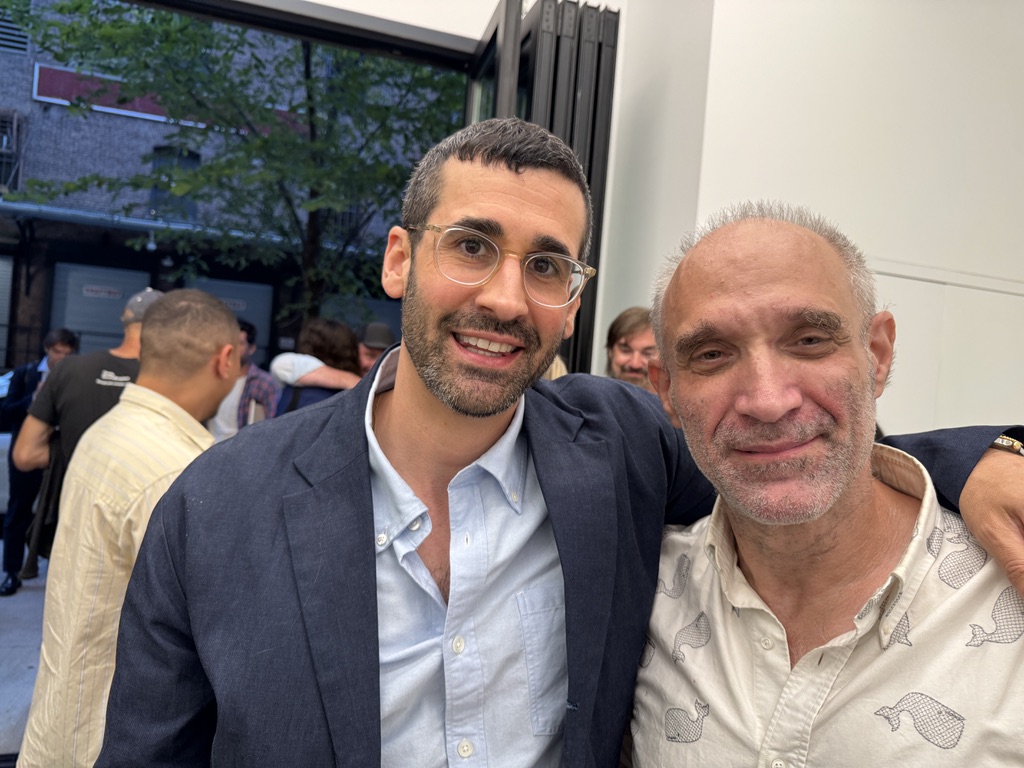
Rimanelli interviewed Carson for her exhibition’s accompanying catalogue, it is revealed to me (or I finally understand) as we leave, so he makes this his final stop. Since I contributed to Austin Martin White’s book, I’ve planned to end my night at Petzel for his opening. I’ll stay for a drink. I love seeing the work that I’ve seen before, in his studio, installed. There are new paintings too. The purple-and-red Massacre of the Children of Bethel Variation 5 (after B. Thompson), 2025, is maybe Austin’s most direct version of the bloody scene, and—via color—it links the other depictions of violence in the show to his unpeopled ruins. It could have been too obvious a move, but I’m so impressed. And the artist looks great in his suit. Upstairs, I find Paige and Domenick again, and chat with Sean Landers about the end of the world.
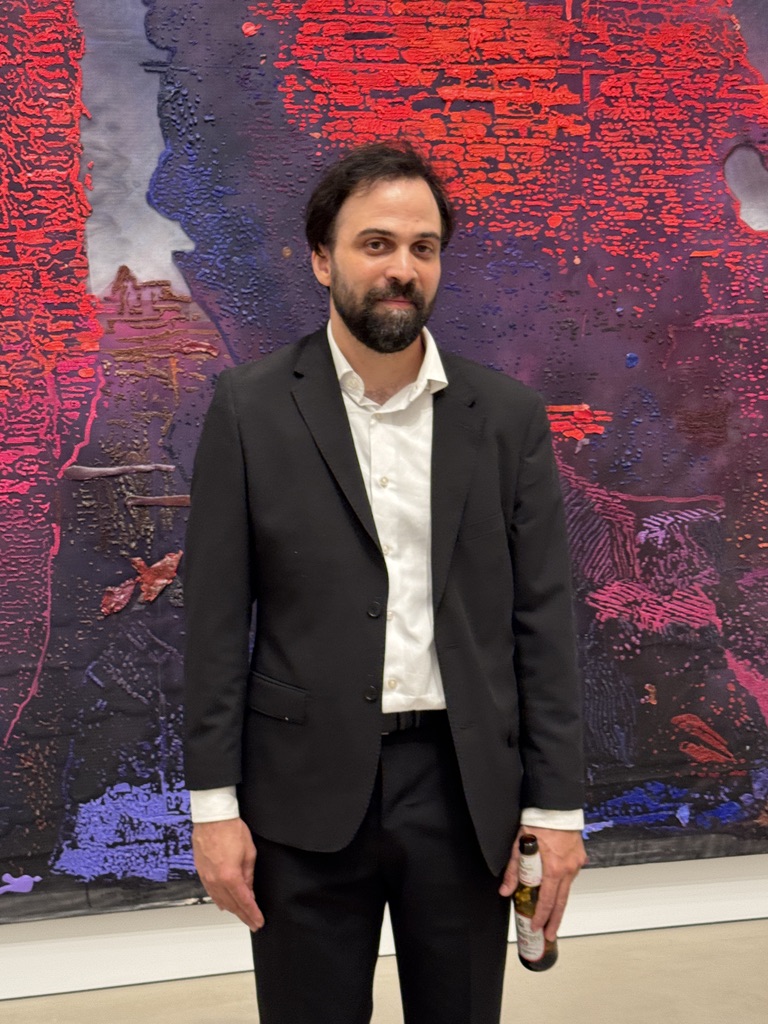
Friday, for painter Sam McKinniss, there’s a lunch at Deitch on Grand. I thought it’d be more like a normal press preview, or maybe an intimate event that’s not in fact intimate at all, but there are just a handful of us—writers—in attendance with Jeffrey Deitch and, of course, Sam. Unbelievably, they’re all people I’m glad to see. We sit down together to eat before walking around the corner to his new painting show “Law & Order.”
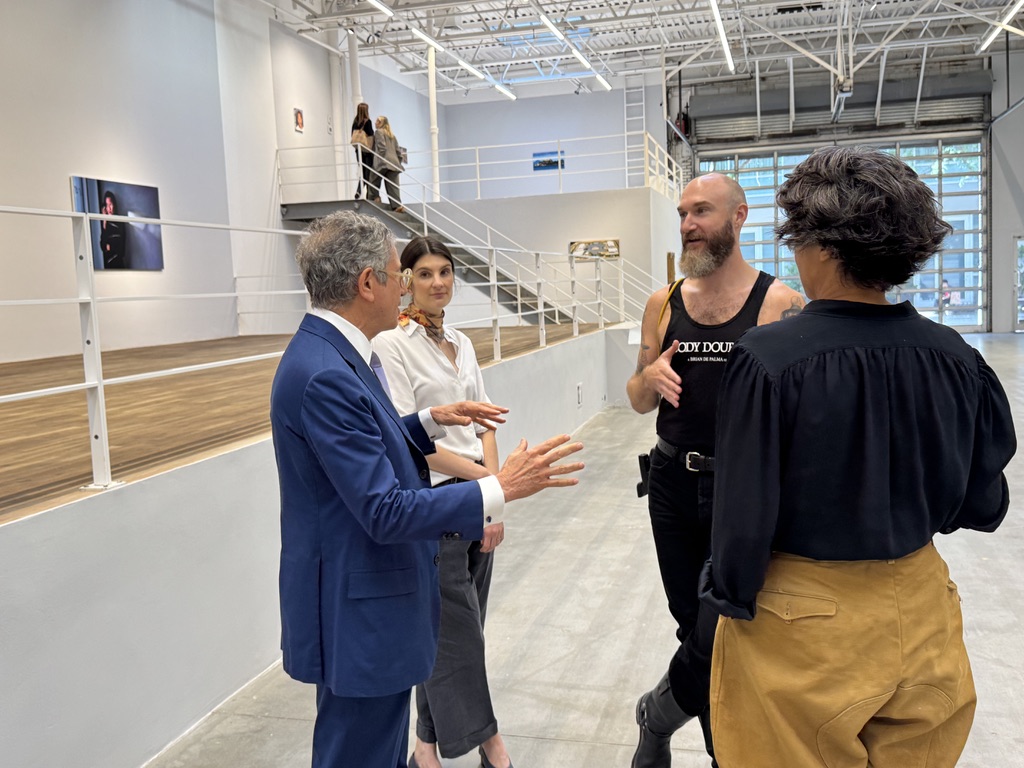
I have a moment with writer Jarrett Earnest and Sam up on the mezzanine, looking at a small painting—a nighttime Manhattan cityscape—that I learn is based on an establishing shot used by David Lynch. It seems like less of a foil to the figurative works, than a connector, like a conjunctive adverb (such as “however”), if you’d like to think of the show as a halting run-on sentence in which Luigi Mangione is the subject of a clause. Sam’s portrait of the alleged assassin on the gallery’s main floor is like the hook of the stupidest (the most efficiently, ruthlessly composed and infectious) pop song. Anyway, it’s not the essayistic quality of the paintings together that matters so much, it’s the ineffable sense of dread that it sustains, the way it keeps the fear ricocheting around, from image to image, no place in the paint to rest or hide. Sam says to us that it’s impossible to paint Gaza; he would never try. He’s trying to capture what everything else looks like during a genocide.
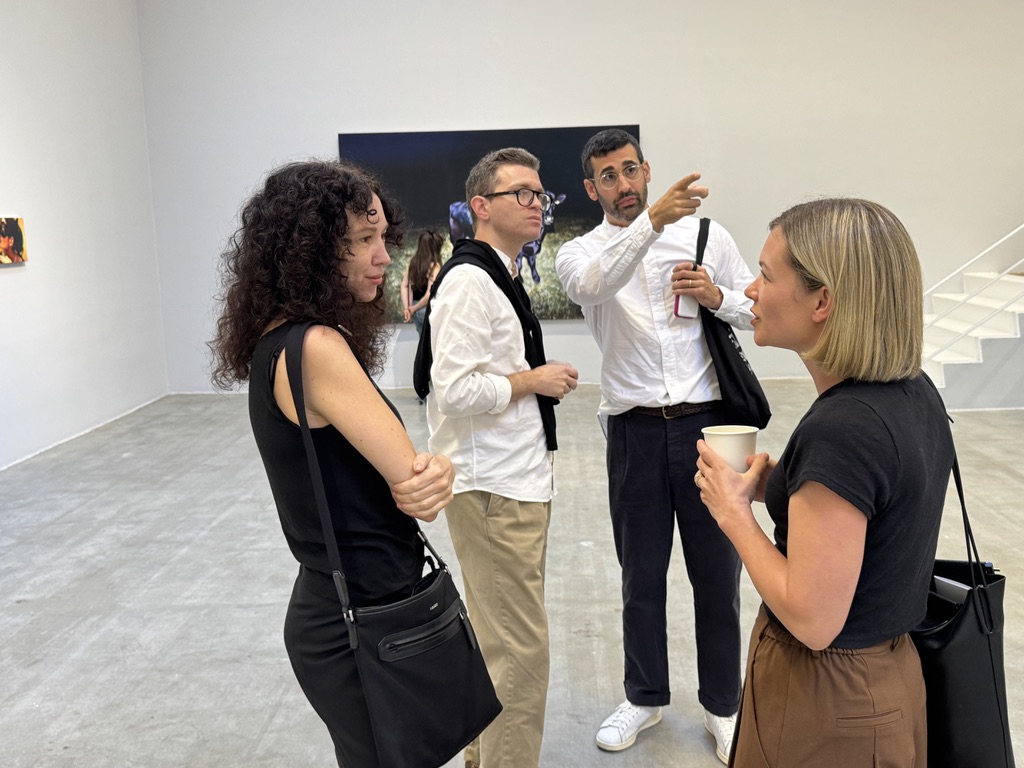
And maybe that’s what Austin and Zoe and a lot of us are thinking about. We’re grappling with the not-new but always-evolving problem of representing violence coupled with the new political conditions of the past two years: the coordinated social and institutional repression of speech that addresses or even names the genocide.
I had planned to go to the Independent, but I go instead with Jarrett to La Mercerie for a drink to catch up, as we’ve been trying to do all summer, before he takes off for the Pines. We have some secret (or as-yet unannounceable) things to discuss. Later, I head to Tribeca, to Open Invitational, the new fair that features work by artists with disabilities. While I can’t speculate on sales overall, I can report anecdotally that every other iPhone at 356 Broadway on Friday had its Stripe app open, and David Fierman (the fair’s founder-organizer) was walking on sunshine. Robert Latchman’s two-sided, sometimes freestanding, paintings—colorful, architecturally inspired compositions presented by Brooklyn’s Land Gallery—were the show-stoppers, but there were treasures at every booth. I buy two 18 x 24” works on paper from the Progressive Art Studio Collective in Detroit (Love Song, by Vanessa Montgomery, a semi-abstract double-portrait in lavender and grass green, and Stephen Tatum’s abstract Shape Connecting #11, both from 2024) and wave at the grinning DJ (Matthew Higgs) as I carry them under my arm out the door.
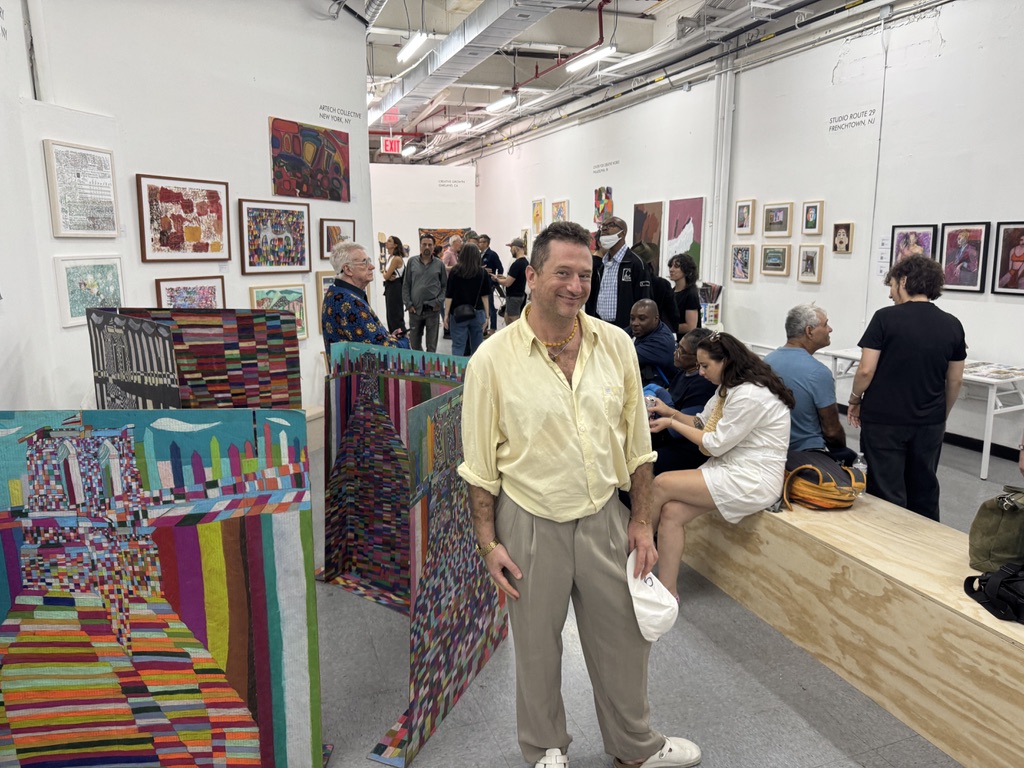
I walk, in the humid night, to Hauser & Wirth’s Wooster Street space, to Ambera Wellmann’s triumphant—but by then emptied-out—opening, and see, with satisfaction, that the big canvases we’d talked about in her studio are now jaw dropping beauties/monsters on the walls; then to Company Gallery, where I find the artist herself, looking gorgeous in a brown suit, fanning herself and drinking an espresso martini from a can. “Congratulations,” I gush, looking around at the packed space, “it’s so great.” I mean it genuinely, but I can’t think of anything smarter, or anything more, to say. Standing awkwardly, sweaty, trying to keep my new acquisitions, sandwiched in bulky cardboard, out of everyone’s way, I decide to call it a night—or actually, a week.



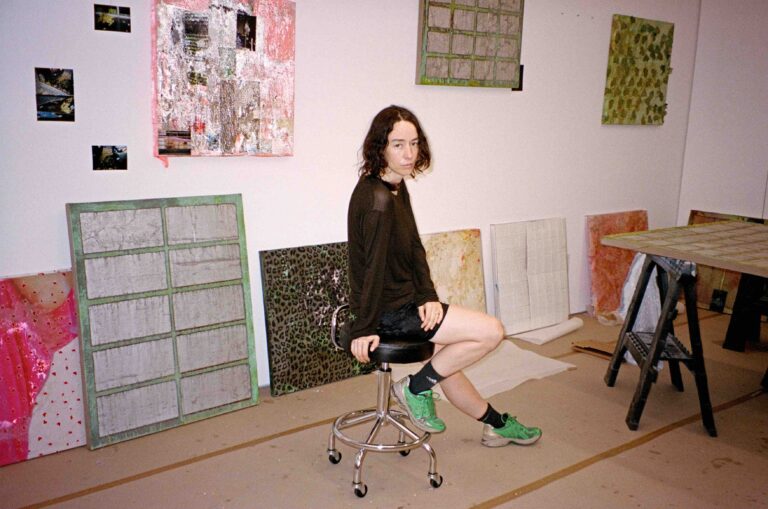


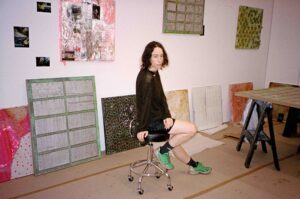



 in your life?
in your life?